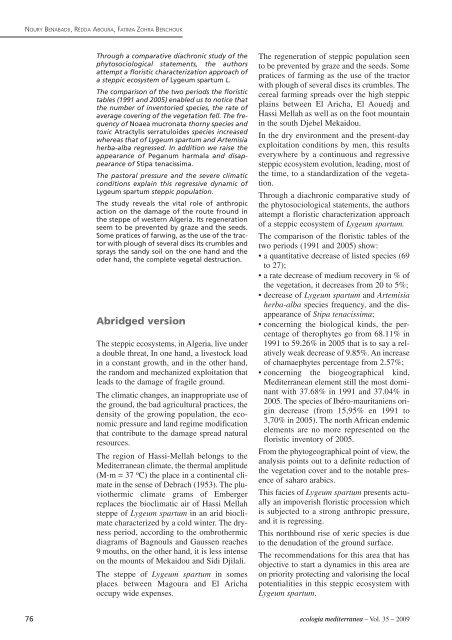Vol. 35 – 2009 - Ecologia Mediterranea - Université d'Avignon et des ...
Vol. 35 – 2009 - Ecologia Mediterranea - Université d'Avignon et des ...
Vol. 35 – 2009 - Ecologia Mediterranea - Université d'Avignon et des ...
You also want an ePaper? Increase the reach of your titles
YUMPU automatically turns print PDFs into web optimized ePapers that Google loves.
NOURY BENABADJI, RÉDDA ABOURA, FATIMA ZOHRA BENCHOUK<br />
76<br />
Through a comparative diachronic study of the<br />
phytosociological statements, the authors<br />
attempt a floristic characterization approach of<br />
a steppic ecosystem of Lygeum spartum L.<br />
The comparison of the two periods the floristic<br />
tables (1991 and 2005) enabled us to notice that<br />
the number of inventoried species, the rate of<br />
average covering of the veg<strong>et</strong>ation fell. The frequency<br />
of Noaea mucronata thorny species and<br />
toxic Atractylis serratuloi<strong>des</strong> species increased<br />
whereas that of Lygeum spartum and Artemisia<br />
herba-alba regressed. In addition we raise the<br />
appearance of Peganum harmala and disappearance<br />
of Stipa tenacissima.<br />
The pastoral pressure and the severe climatic<br />
conditions explain this regressive dynamic of<br />
Lygeum spartum steppic population.<br />
The study reveals the vital role of anthropic<br />
action on the damage of the route fround in<br />
the steppe of western Algeria. Its regeneration<br />
seem to be prevented by graze and the seeds.<br />
Some pratices of farwing, as the use of the tractor<br />
with plough of several discs its crumbles and<br />
sprays the sandy soil on the one hand and the<br />
oder hand, the compl<strong>et</strong>e veg<strong>et</strong>al <strong>des</strong>truction.<br />
Abridged version<br />
The steppic ecosystems, in Algeria, live under<br />
a double threat, In one hand, a livestock load<br />
in a constant growth, and in the other hand,<br />
the random and mechanized exploitation that<br />
leads to the damage of fragile ground.<br />
The climatic changes, an inappropriate use of<br />
the ground, the bad agricultural practices, the<br />
density of the growing population, the economic<br />
pressure and land regime modification<br />
that contribute to the damage spread natural<br />
resources.<br />
The region of Hassi-Mellah belongs to the<br />
<strong>Mediterranea</strong>n climate, the thermal amplitude<br />
(M-m = 37 oC) the place in a continental climate<br />
in the sense of Debrach (1953). The pluviothermic<br />
climate grams of Emberger<br />
replaces the bioclimatic air of Hassi Mellah<br />
steppe of Lygeum spartum in an arid bioclimate<br />
characterized by a cold winter. The dryness<br />
period, according to the ombrothermic<br />
diagrams of Bagnouls and Gaussen reaches<br />
9 mouths, on the other hand, it is less intense<br />
on the mounts of Mekaidou and Sidi Djilali.<br />
The steppe of Lygeum spartum in somes<br />
places b<strong>et</strong>ween Magoura and El Aricha<br />
occupy wide expenses.<br />
The regeneration of steppic population seen<br />
to be prevented by graze and the seeds. Some<br />
pratices of farming as the use of the tractor<br />
with plough of several discs its crumbles. The<br />
cereal farming spreads over the high steppic<br />
plains b<strong>et</strong>ween El Aricha, El Aouedj and<br />
Hassi Mellah as well as on the foot mountain<br />
in the south Djebel Mekaidou.<br />
In the dry environment and the present-day<br />
exploitation conditions by men, this results<br />
everywhere by a continuous and regressive<br />
steppic ecosystem evolution, leading, most of<br />
the time, to a standardization of the veg<strong>et</strong>ation.<br />
Through a diachronic comparative study of<br />
the phytosociological statements, the authors<br />
attempt a floristic characterization approach<br />
of a steppic ecosystem of Lygeum spartum.<br />
The comparison of the floristic tables of the<br />
two periods (1991 and 2005) show:<br />
• a quantitative decrease of listed species (69<br />
to 27);<br />
• a rate decrease of medium recovery in % of<br />
the veg<strong>et</strong>ation, it decreases from 20 to 5%;<br />
• decrease of Lygeum spartum and Artemisia<br />
herba-alba species frequency, and the disappearance<br />
of Stipa tenacissima;<br />
• concerning the biological kinds, the percentage<br />
of therophytes go from 68.11% in<br />
1991 to 59.26% in 2005 that is to say a relatively<br />
weak decrease of 9.85%. An increase<br />
of chamaephytes percentage from 2.57%;<br />
• concerning the biogeographical kind,<br />
<strong>Mediterranea</strong>n element still the most dominant<br />
with 37.68% in 1991 and 37.04% in<br />
2005. The species of Ibéro-mauritaniens origin<br />
decrease (from 15,95% en 1991 to<br />
3,70% in 2005). The north African endemic<br />
elements are no more represented on the<br />
floristic inventory of 2005.<br />
From the phytogeographical point of view, the<br />
analysis points out to a definite reduction of<br />
the veg<strong>et</strong>ation cover and to the notable presence<br />
of saharo arabics.<br />
This facies of Lygeum spartum presents actually<br />
an impoverish floristic procession which<br />
is subjected to a strong anthropic pressure,<br />
and it is regressing.<br />
This northbound rise of xeric species is due<br />
to the denudation of the ground surface.<br />
The recommendations for this area that has<br />
objective to start a dynamics in this area are<br />
on priority protecting and valorising the local<br />
potentialities in this steppic ecosystem with<br />
Lygeum spartum.<br />
ecologia mediterranea <strong>–</strong> <strong>Vol</strong>. <strong>35</strong> <strong>–</strong> <strong>2009</strong>
















